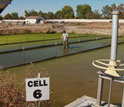News Release 11-167
NSF Launches New Engineering Research Centers with Awards Totaling $74.0 Million
Four new centers will pursue innovations in large-scale solar energy, sustainable water systems, sensorimotor neural engineering and energy transmission networks

A University of Washington doctoral student interacts with a lifelike robotic hand.
August 17, 2011
This material is available primarily for archival purposes. Telephone numbers or other contact information may be out of date; please see current contact information at media contacts.
The National Science Foundation (NSF) today announced the award of $74 million to create four new Engineering Research Centers (ERCs) that will advance interdisciplinary research and education in partnership with industry.
During the next five years, the ERCs will share the goal of creating knowledge and innovations that address significant societal issues such as health and sustainability challenges while advancing the competitiveness of U.S. industry. The centers will support research and innovation in solar energy, water infrastructure, neural engineering and energy transmission.
For the first time, NSF's investment in two of these centers will be matched by another federal agency--NSF and the Department of Energy will co-fund the ERCs investigating solar energy and energy transmission.
"Through this partnership, as with partnerships between NSF and industry, we bring together complementary strategic objectives," said Thomas Peterson, NSF's assistant director for Engineering. "Jointly-funded ERCs will have unique opportunities to advance basic and translational research and to shape the energy workforce--all of which will be essential for energy innovation."
Since 1985, the ERC program has fostered broad-based research and education collaborations to focus on creating technological breakthroughs for new products and services and on preparing U.S. engineering graduates to successfully participate in the global economy. The four centers launched this year, as part of the third generation of NSF ERCs, place increased emphasis on innovation and entrepreneurship, partnerships with small research firms, and international collaboration and cultural exchange.
"The Gen-3 ERCs are designed to speed the process of transitioning knowledge into innovation and to provide young engineers with experience in research and entrepreneurship, strengthening their role as innovation leaders in the global economy," said Lynn Preston, the leader of the ERC Program. "Because they build on the rich understanding we gained from two previous generations of ERCs, we expect these new centers to make even more significant impacts on the competitiveness of U.S. industry."
Including the new awards, NSF supports 17 ERCs in the areas of biotechnology and health care; energy, sustainability, and infrastructure; and microelectronics, sensing, and information technology. Brief descriptions of the new centers follow.
The NSF ERC for Re-inventing America's Urban Water Infrastructure, led by Stanford University, will seek sustainable urban water systems to supply, treat, and reuse water.
The NSF ERC for Sensorimotor Neural Engineering, led by the University of Washington, will pursue the ideal mind-machine interface and other devices to restore and augment health.
The NSF-DOE ERC for Quantum Energy and Sustainable Solar Technologies (QESST), led by Arizona State University, will aim to make solar energy technologies sustainable, ubiquitous, and multifunctional.
The NSF-DOE ERC for Ultra-wide-area Resilient Electric Energy Transmission Networks (CURENT), led by the University of Tennessee, Knoxville, will create transforming technologies to allow reliable, secure, and efficient operation of the electricity transmission infrastructure across vast distances.
Read more about ERCs and the innovation ecosystem in "What is an Innovation Ecosystem?"
-NSF-
-
How natural and engineered systems may work together will be studied at a wetland testbed.
Credit and Larger Version -
The design and manufacture of advanced photovoltaics will be the focus of the NSF-DOE QESST ERC.
Credit and Larger Version -
Students will be among the researchers creating technologies to improve electricity transmission.
Credit and Larger Version
Media Contacts
Joshua A. Chamot, NSF, (703) 292-7730, email: jchamot@nsf.gov
Public Affairs, DOE, (202) 586-4940
Hannah Hickey, University of Washington, (206) 543-2580, email: hickeyh@uw.edu
Joe Kullman, Arizona State University, (480) 965-8122, email: joe.kullman@asu.edu
Andrew Myers, Stanford University, (650) 736-2245, email: admyers@stanford.edu
Margie Nichols, University of Tennessee, Knoxville, (865) 974-3309, email: mnichols@utk.edu
Program Contacts
Lynn Preston, Leader of the NSF ERC Program, (703) 292-5358, email: lpreston@nsf.gov
Paul L. Bishop, NSF Program Officer for the NSF ERC for Re-inventing America’s Urban Water Infrastructure, (703) 292-2161, email: pbishop@nsf.gov
Theresa A. Good, NSF Program Officer for the NSF ERC for Sensorimotor Neural Engineering, (703) 292-7029, email: tgood@nsf.gov
Barbara H. Kenny, NSF Program Officer for the NSF-DOE ERC for Quantum Energy and Sustainable Solar Technologies (QESST) and the NSF-DOE ERC for Ultra-wide-area Resilient Electric Energy Transmission Networks (CURENT), (703) 292-4667, email: bkenny@nsf.gov
Minh Le, DOE Solar Energy Technologies Program, (202) 587-1372, email: Minh.Le@ee.doe.gov
Philip Overholt, DOE Office of Electricity Delivery and Energy Reliability, (202) 586-8110, email: Philip.Overholt@hq.doe.gov
Cecile J. Gonzalez, NSF, (703) 292-8538, email: cjgonzal@nsf.gov
Principal Investigators
Christiana Honsberg, Arizona State University, (480) 965-2831, email: honsberg@asu.edu
Richard Luthy, Stanford University, (650) 723-3921, email: luthy@stanford.edu
Yoky Matsuoka, University of Washington, (206) 616-0621, email: yoky@cs.washington.edu
Kevin Tomsovic, University of Tennessee, Knoxville, (865) 974-3461, email: tomsovic@tennessee.edu
Related Websites
NSF ERC for Re-inventing America’s Urban Water Infrastructure: http://www.UrbanWaterERC.org
NSF ERC for Sensorimotor Neural Engineering: http://csne.washington.edu
NSF-DOE ERC for Quantum Energy and Sustainable Solar Technologies (QESST): http://qesst.org/
NSF-DOE ERC for Ultra-wide-area Resilient Electric Energy Transmission Networks (CURENT): http://curent.utk.edu/
ERC Program Website: http://www.erc-assoc.org
DOE Office of Electricity Delivery and Energy Reliability: http://www.oe.energy.gov/
The U.S. National Science Foundation propels the nation forward by advancing fundamental research in all fields of science and engineering. NSF supports research and people by providing facilities, instruments and funding to support their ingenuity and sustain the U.S. as a global leader in research and innovation. With a fiscal year 2023 budget of $9.5 billion, NSF funds reach all 50 states through grants to nearly 2,000 colleges, universities and institutions. Each year, NSF receives more than 40,000 competitive proposals and makes about 11,000 new awards. Those awards include support for cooperative research with industry, Arctic and Antarctic research and operations, and U.S. participation in international scientific efforts.
Connect with us online
NSF website: nsf.gov
NSF News: nsf.gov/news
For News Media: nsf.gov/news/newsroom
Statistics: nsf.gov/statistics/
Awards database: nsf.gov/awardsearch/
Follow us on social
Twitter: twitter.com/NSF
Facebook: facebook.com/US.NSF
Instagram: instagram.com/nsfgov



